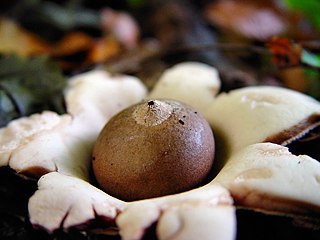
Geastrales is an order of gasterocarpic basidiomycetes (fungi) that are related to Cantharellales. The order contains the single family Geastraceae, commonly known as "earthstars", which older classifications had placed in Lycoperdales, or Phallales.

The Russulales are an order of the Agaricomycetes,. According to the Dictionary of the Fungi, the order consists of 12 families, 80 genera, and 1767 species. According to Species Fungorum, the order contains 13 families, 117 genera, and 3,060 species.
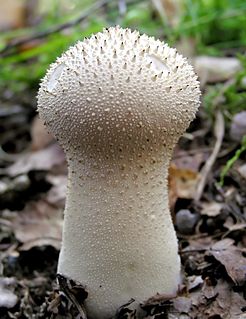
Lycoperdon perlatum, popularly known as the common puffball, warted puffball, gem-studded puffball, wolf farts or the devil's snuff-box, is a species of puffball fungus in the family Agaricaceae. A widespread species with a cosmopolitan distribution, it is a medium-sized puffball with a round fruit body tapering to a wide stalk, and dimensions of 1.5 to 6 cm wide by 3 to 10 cm tall. It is off-white with a top covered in short spiny bumps or "jewels", which are easily rubbed off to leave a netlike pattern on the surface. When mature it becomes brown, and a hole in the top opens to release spores in a burst when the body is compressed by touch or falling raindrops.

The Ustilaginales are an order of fungi within the class Ustilaginomycetes. The order contains 8 families, 49 genera, and 851 species.
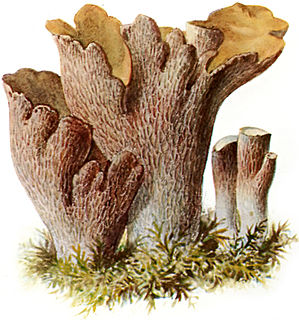
The Gomphaceae are a diverse family of fungi belonging in what is classically known as the Phallales or cladistically as the gomphoid-phalloid clade. The family has 13 genera and 287 species.
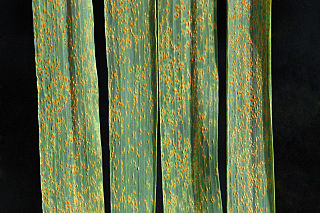
Puccinia is a genus of fungi. All species in this genus are obligate plant pathogens and are known as rusts. The genus contains about 4000 species.

Verpa is a genus of ascomycete fungi related to the morels. Resembling the latter genus in edibility and form, the common name early morels is popular. There are five species in the widespread genus.

The Pleurotaceae are a family of small to medium-sized mushrooms which have white spores. The family contains four genera and 94 species. Members of Pleurotaceae can be mistaken for members of Marasmiaceae. Perhaps the best known member is the oyster mushroom, Pleurotus ostreatus.

Hydnellum is a genus of tooth fungi in the family Bankeraceae. Widely distributed in the Northern Hemisphere, the genus contains around 40 species. The fruitbodies of its members grow by slowly enveloping nearby bits of grass and vegetation. There is great variability in the form of Hydnellum fruitbodies, which are greatly influenced by environmental conditions such as rainfall and humidity, drying winds, and temperature. They are too tough and woody to eat comfortably. Several species have become the focus of increasing conservation concern following widespread declines in abundance.

The Taphrinomycetes are a class of ascomycete fungi belonging to the subdivision Taphrinomycotina. It includes the single order Taphrinales, which includes 2 families, 8 genera and 140 species.

Bovista is a genus of fungi commonly known as the true puffballs. It was formerly classified within the now-obsolete order Lycoperdales, which, following a restructuring of fungal taxonomy brought about by molecular phylogeny, has been split; the species of Bovista are now placed in the family Agaricaceae of the order Agaricales. Bovista species have a collectively widespread distribution, and are found largely in temperate regions of the world. Various species have historically been used in homeopathic preparations.

The Lecanorales are an order of mostly lichen-forming fungi belonging to the class Lecanoromycetes in the division Ascomycota. The order contains 26 families, 269 genera, and 5695 species.
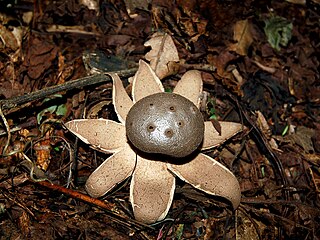
Myriostoma is a fungal genus in the family Geastraceae. Basidiocarps resemble earthstars, but the spore sac is supported by multiple columns and has multiple ostioles instead of a single, apical ostiole. Until 2017, the genus was thought to be monotypic with a single, widespread species, Myriostoma coliforme. Recent research has, however, shown that at least six species occur worldwide.

Astraeus hygrometricus, commonly known as the hygroscopic earthstar, the barometer earthstar, or the false earthstar, is a species of fungus in the family Diplocystaceae. Young specimens resemble a puffball when unopened. In maturity, the mushroom displays the characteristic earthstar shape that is a result of the outer layer of fruit body tissue splitting open in a star-like manner. The false earthstar is an ectomycorrhizal species that grows in association with various trees, especially in sandy soils. A. hygrometricus was previously thought to have a cosmopolitan distribution, though it is now thought to be restricted to Southern Europe, and Astraeus are common in temperate and tropical regions. Its common names refer to the fact that it is hygroscopic (water-absorbing), and can open up its rays to expose the spore sac in response to increased humidity, and close them up again in drier conditions. The rays have an irregularly cracked surface, while the spore case is pale brown and smooth with an irregular slit or tear at the top. The gleba is white initially, but turns brown and powdery when the spores mature. The spores are reddish-brown, roughly spherical with minute warts, measuring 7.5–11 micrometers in diameter.
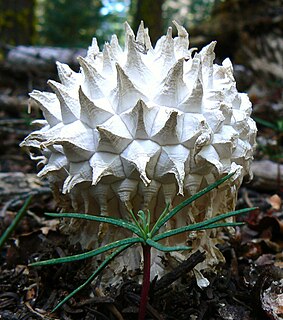
Calvatia sculpta, commonly known as the sculpted puffball, the sculptured puffball, the pyramid puffball, and the Sierran puffball, is a species of puffball fungus in the family Agaricaceae. Attaining dimensions of up to 8 to 15 cm tall by 8 to 10 cm wide, the pear- or egg-shaped puffball is readily recognizable because of the large pyramidal or polygonal warts covering its surface. It is edible when young, before the spores inside the fruit body disintegrate into a brownish powder. The spores are roughly spherical, and have wart-like projections on their surfaces.
Polytolypa is a monotypic genus of fungus containing the single species Polytolypa hystricis. First classified in the Onygenaceae family, as of 2008 it is considered to be in the Ajellomycetaceae, although there is still uncertainty as to its phylogenetic relationships with other similar genera. This species is only known from a single specimen derived in the laboratory from a specimen of dung of the North American porcupine, Erethizon dorsatum, collected in Ontario, Canada. Polytolypa hystricis contains bioactive compounds that have antifungal activity.

The Atractiellomycetes are class of fungi in the Pucciniomycotina subdivision of the Basidiomycota. The class consists of a single order, the Atractiellales, which contains 3 families, 10 genera, and 34 species. Leucogloea and Hobsonia are genera incertae sedis with respect to familial placement.

In biology, a sterigma is a small supporting structure.
The Microbotryales are an order of fungi in the Microbotryomycetes class of the Basidiomycota. The order contains 2 families, 9 genera, and 114 species. The order was circumscribed in 1997.

Sclerodermatineae is a suborder of the fungal order Boletales. Circumscribed in 2002 by mycologists Manfred Binder and Andreas Bresinsky, it contains nine genera and about 80 species. The suborder contains a diverse assemblage fruit body morphologies, including boletes, gasteroid forms, earthstars, and puffballs. Most species are ectomycorrhizal, although the ecological role of some species is not known with certainty. The suborder is thought to have originated in the late Cretaceous (145–66 Ma) in Asia and North America, and the major genera diversified around the mid Cenozoic (66–0 Ma).


















